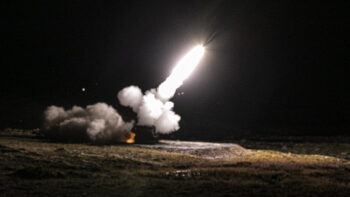
U.S. Army Staff Sgt. Jacob Edwards, assigned to 4th Squadron, 2nd Cavalry Regiment, completes Defense Advanced GPS Receiver operations during the Victory Corps’ Walter D. Ehlers Cup, at Grafenwoehr, Germany, June 4, 2023. (US Army Photo by Sgt. Khalan Moore)
GEOINT 2024 — Rather than focusing on one type of the technology, the Army is seeking out a diverse range of alternatives to GPS satellites to provide positioning, navigation and timing (PNT) signals, according to the service’s lead official on the “alt-PNT” effort.
The Army has hundreds of different platforms that use Global Positioning System satellite signals to navigate, explained Michael Monteleone, director of Army Futures Command’s new All-Domain Sensing Cross-Functional Team (CFT), on Sunday.
“From the Army perspective, it’s going to be a little bit different for us in every domain. So, if I’m on the ground, there are certain things I can take advantage of from just simply being on the ground that maybe I can’t if I’m airborne, or if I’m a precision-guided munition moving at an incredible speed, perhaps maybe spinning while I’m in the air,” he told Breaking Defense and Defense News here in Kissimmee, Fla. at the United States Geospatial Intelligence Foundation’s annual conference.
“All of that impacts what we would use, so we look at kind of everything,” he said.
Further, Monteleone stressed, the service needs to be strategic about what sensors and capabilities are put on what platforms based on missions and costs as it moves to enable its plans for a revamped force structure revolving around human-machine integration.
“I don’t want to take a very expensive, very, very capable [alternative] PNT system that belongs on a, let’s say, a Stryker platform or an Abrams tank or something like that, and … stick it on the robot that is the one that I’m training to take first contact,” Monteleone explained.
The cost factor also comes in to play for those uses of PNT that require large-scale deployment — think handheld systems for soldiers or those worn on their person, Monteleone said.
“We’ve got to say: ‘Is it affordable’?” he stressed.
For those sorts of missions, Monteleone said the service is eyeing how to take advantage of commercial innovation.
“If you can on your phone say: ‘Hey, please deliver me this package to my house and in under two hours,’ and there’s a drone that flew from somewhere — in some wet weather conditions through who knows what, and didn’t hit a tree, didn’t hit a telephone pole, didn’t land on the neighbor’s cat — delivered that package in that timeframe — I want to take advantage of every bit of that technology.”
“I would love to see more commoditized capability,” Monteleone said. “I can’t live in the world of ‘it worked in the lab.’ I need to start getting it into an applied sense and then say, ‘Okay, the technology works, how would I incorporate it into our battle weapon systems platforms, and then how can I use that as an advantage’?”
Monteleone said that fortunately there are a lot of new, improved sensor technologies that can be used to provide PNT coming to fruition for near-term use.
One example, he said, is quantum sensing.
“From a quantum sensing perspective, there’s an incredible amount of innovation that’s happening and things becoming more and more real, demonstrable type capabilities,” Monteleone said.
Quantum sensors for PNT use atomic accelerometers or gyroscopes that use lasers to “measure acceleration and rotation by shining lasers into small clouds of rubidium gas” contained in vacuum chambers, according to Sandia National Laboratories, which has been undertaking research into their use.
Another alt-PNT technology of interest for the Army is so-called magnetic navigation, or mag-nav, that relies on mapping the magnetic fields in the Earth’s crust, according to Monteleone and other experts speaking at a panel on alt-PNT during the GEOINT conference on Sunday.
Not only are mag-nav systems impossible to jam or spoof, they also are “passive systems” that don’t require broadcasting signals — thus don’t make the use of PNT systems a means to target US forces, Nikki Markiel, senior GEOINT authority for geomatics at the National Geospatial-Intelligence Agency told the panel.
Monteleone added, “Mag-nav is interesting because you can use it across multiple domains as well.”






















